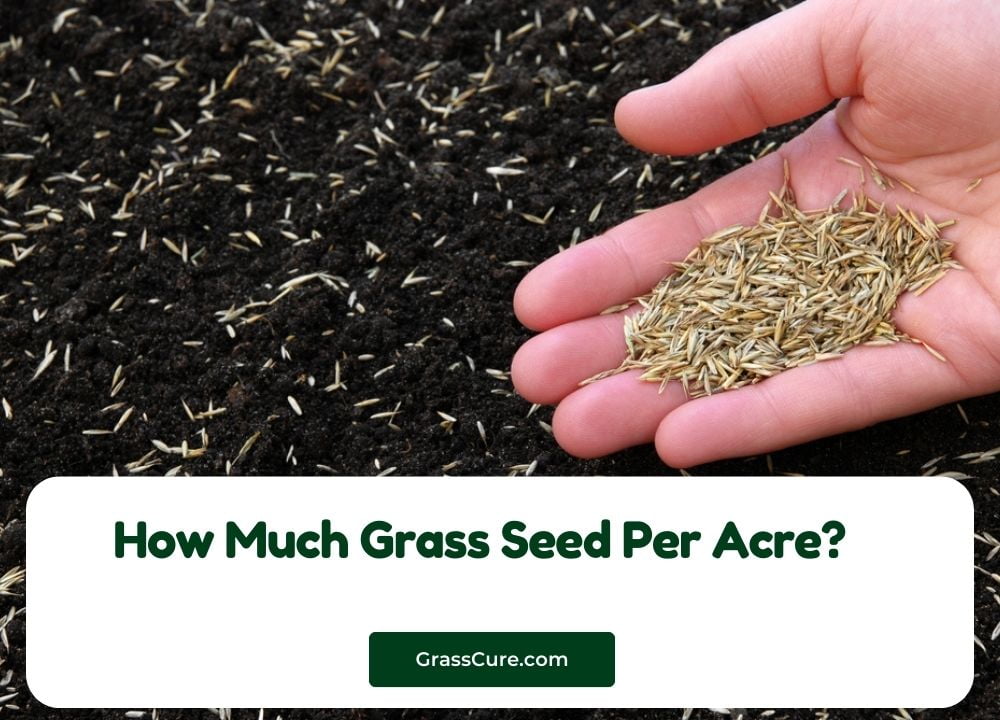Establishing a lush, healthy lawn or pasture begins with the right amount of grass seed. Whether you’re aiming to create a vibrant residential yard, a durable sports field, or a productive pasture, understanding how much grass seed to use per acre is crucial. The proper seeding rate not only ensures optimal growth but also helps prevent issues like overcrowding or bare patches. In this guide, we will explore the factors that influence grass seed rates, provide general guidelines for different applications, and offer best practices for achieving successful grass establishment. Let’s dive into the essential considerations for effective seeding!
Guide How Much Grass Seed Per Acre
Understanding Grass Seed Basics
Before determining how much grass seed to apply per acre, it’s essential to grasp the fundamentals of grass seed. This section will cover the different types of grass seeds, their characteristics, and the importance of seed quality.
Grass Seed Types
Cool-Season Grasses
Ideal for northern climates with colder winters and moderate summers.
Examples include Kentucky bluegrass, fescue, and ryegrass.
Thrive during the spring and fall, making them suitable for cool-weather regions.
Warm-Season Grasses
Best suited for southern climates with hot summers and mild winters.
Examples include Bermuda grass, Zoysia grass, and buffalo grass.
Grow most actively in late spring and summer, providing excellent heat tolerance.
Seed Quality
- Germination Rates
- The percentage of seeds that will sprout and grow successfully.
- Higher germination rates lead to a denser, healthier lawn.
- Purity
- Refers to the amount of pure grass seed in a bag compared to weeds and other species.
- High-purity seeds minimize competition from unwanted plants.
- Freshness
- The age of the seed can affect its viability; always check the packaging for a “packed on” date.
- Using fresh seeds ensures better germination and establishment.
Choosing the Right Grass Type
Selecting the appropriate grass type is crucial for successful growth. Factors to consider include:
- Climate: Match grass types to your local weather patterns to ensure optimal performance.
- Purpose: Consider the intended use of the grass (e.g., recreational, ornamental, or forage) to select a suitable species.
- Maintenance Level: Some grasses require more care and maintenance than others; choose a type that aligns with your desired upkeep effort.
Understanding these basics will set the foundation for determining the right seeding rate and achieving a thriving lawn or pasture.
Factors Influencing Seed Rates
When determining the amount of grass seed to apply per acre, several key factors come into play. Understanding these factors can help you make informed decisions to achieve optimal growth and establishment. Here are the primary considerations:
A. Soil Quality and Conditions
- Soil Type
- Different soil types (sandy, clay, loamy) affect seed-to-soil contact, water retention, and nutrient availability.
- Sandy soils may require higher seed rates due to their drainage capabilities, while clay soils might require less seed as they retain moisture more effectively.
- Soil Preparation
- Proper site preparation, including tilling and amending the soil, can enhance seed germination.
- Well-prepared soil provides a favorable environment for seed establishment, potentially reducing the required seed rate.
- Nutrient Levels
- Conducting a soil test can help identify nutrient deficiencies.
- Fertilizing before seeding can improve growth rates and reduce the need for excess seed.
B. Intended Use of the Grass
- Residential Lawns
- Typical seeding rates range from 3 to 8 pounds of seed per 1,000 square feet, depending on the grass type.
- For a denser lawn, especially in high-traffic areas, opt for higher seeding rates.
- Sports Fields and Commercial Turf
- These areas typically require higher seed rates (8 to 12 pounds per 1,000 square feet) to withstand wear and tear.
- Select mixtures that provide quick establishment and durability.
- Pastures and Hay Production
- Seed rates may vary based on livestock needs, desired forage quality, and species selected.
- Generally, seeding rates for pasture grasses range from 10 to 25 pounds per acre, depending on the mixture and intended use.
C. Climate and Regional Considerations
- Temperature and Weather Patterns
- Local climate conditions, such as average temperature and rainfall, can influence grass growth and establishment.
- In cooler regions, cool-season grasses may establish more quickly, while warm-season grasses thrive in hotter conditions.
- Elevation and Drainage
- Higher elevations may have cooler temperatures that affect germination and growth rates.
- Well-drained areas may require adjustments to seeding rates to prevent seed loss due to erosion or washout.
- Local Pests and Diseases
- Understanding common pests and diseases in your area can help you select resistant grass varieties and determine appropriate seeding rates.
General Guidelines for Grass Seed Application Rates
Determining the correct grass seed application rate is essential for achieving a lush, healthy lawn or pasture. The following guidelines provide recommended seeding rates based on various applications and grass types, ensuring optimal growth and establishment.
A. Residential Lawns
- Recommended Seed Rates
- Cool-Season Grasses: Generally, apply 3 to 8 pounds of seed per 1,000 square feet.
- For Kentucky bluegrass: 1 to 2 pounds per 1,000 square feet.
- For tall fescue: 6 to 8 pounds per 1,000 square feet.
- Warm-Season Grasses: Typically, use 1 to 3 pounds per 1,000 square feet.
- For Bermuda grass: 1 to 2 pounds per 1,000 square feet.
- Cool-Season Grasses: Generally, apply 3 to 8 pounds of seed per 1,000 square feet.
- Tips for a Lush Lawn
- For denser lawns, increase the seed rate towards the higher end of the range, particularly in high-traffic areas.
- Mix different grass types to enhance resilience and adaptability.
B. Sports Fields and Commercial Turf
- Higher Density Requirements
- Recommended seed rates typically range from 8 to 12 pounds per 1,000 square feet.
- For perennial ryegrass or a sports field blend: 8 to 10 pounds per 1,000 square feet.
- For Bermuda grass on athletic fields: 3 to 5 pounds per 1,000 square feet.
- Considerations for Performance
- Opt for quick germinating and durable grass mixtures to withstand heavy use and provide a uniform playing surface.
- Regular overseeding may be necessary to maintain density and vigor.
C. Pastures and Hay Fields
- Seeding Rates for Forage Production
- The general recommendation for pasture grasses ranges from 10 to 25 pounds per acre, depending on the mixture and specific grass species.
- For a mixed pasture with legumes (like clover), adjust the seed rate to account for competition and complementarity.
- Types of Grasses and Their Rates
- For tall fescue or orchard grass: 15 to 25 pounds per acre.
- For a mixed pasture (including legumes): 8 to 12 pounds per acre for grasses, combined with 4 to 6 pounds of legumes.
- Strategies for Optimal Forage Growth
- Consider rotational grazing and nutrient management to enhance growth and reduce the need for reseeding.
Calculating Seed Needs
Calculating the right amount of grass seed to apply is crucial for ensuring successful establishment and growth. This section outlines how to determine seed needs based on area measurements, seed package guidelines, and adjustments for specific methods of application.
A. Converting Acres to Square Feet
- Understanding the Conversion
- One acre is equal to 43,560 square feet.
- To convert the area you are working with into square feet, use the formula: Square Feet=Acres×43,560\text{Square Feet} = \text{Acres} \times 43,560Square Feet=Acres×43,560
- Examples
- For a 0.5-acre area: 0.5 acres×43,560 square feet/acre=21,780 square feet0.5 \text{ acres} \times 43,560 \text{ square feet/acre} = 21,780 \text{ square feet}0.5 acres×43,560 square feet/acre=21,780 square feet
- For a 2-acre area: 2 acres×43,560 square feet/acre=87,120 square feet2 \text{ acres} \times 43,560 \text{ square feet/acre} = 87,120 \text{ square feet}2 acres×43,560 square feet/acre=87,120 square feet
B. Seed Pack Instructions
- Reading the Seed Package
- Seed packages typically provide recommended application rates in pounds per 1,000 square feet or per acre.
- Take note of the specific seeding rate recommended for the grass type you plan to use.
- Calculating Total Seed Requirement
- Use the following formula: Total Seed Needed (lbs)=(Recommended Seed Rate (lbs/1,000 sq ft)1,000)×Total Square Feet\text{Total Seed Needed (lbs)} = \left(\frac{\text{Recommended Seed Rate (lbs/1,000 sq ft)}}{1,000}\right) \times \text{Total Square Feet}Total Seed Needed (lbs)=(1,000Recommended Seed Rate (lbs/1,000 sq ft))×Total Square Feet
- Examples
- For a lawn requiring 6 lbs per 1,000 sq ft over an area of 21,780 sq ft: Total Seed Needed=(61,000)×21,780≈130.68 lbs\text{Total Seed Needed} = \left(\frac{6}{1,000}\right) \times 21,780 \approx 130.68 \text{ lbs}Total Seed Needed=(1,0006)×21,780≈130.68 lbs
- For a pasture needing 15 lbs per acre:
- If the area is 2 acres, then you would need:
C. Adjustments for Overlapping Seeding
- Using a Seeder or Broadcast Method
- When using a broadcast seeder or a drill, consider the overlap that may occur during the application.
- It’s common to adjust the seed rate to account for overlaps (generally 10-15% more seed may be required).
- Calculating Overlap Adjustments
- If your total calculated seed requirement is 100 lbs and you expect a 10% overlap: Adjusted Seed Rate=Total Seed Needed×(1+0.10)=100 lbs×1.10=110 lbs\text{Adjusted Seed Rate} = \text{Total Seed Needed} \times (1 + 0.10) = 100 \text{ lbs} \times 1.10 = 110 \text{ lbs}Adjusted Seed Rate=Total Seed Needed×(1+0.10)=100 lbs×1.10=110 lbs
Best Practices for Seeding
Achieving successful grass establishment involves more than just applying the right amount of seed; it requires careful planning and execution. Here are some best practices to follow for effective seeding:
A. Timing and Seasonal Considerations
- Cool-Season Grasses
- The best time to seed is in early spring or early fall when temperatures are moderate.
- Fall seeding allows for root development before winter, while spring seeding benefits from optimal growing conditions.
- Warm-Season Grasses
- Seed in late spring to early summer when soil temperatures are consistently above 65°F.
- This timing encourages rapid growth and establishment during the warm months.
B. Preparing the Site for Seeding
- Soil Testing and Amendments
- Conduct a soil test to determine pH and nutrient levels.
- Amend the soil with lime or fertilizer as necessary to create optimal conditions for grass growth.
- Clearing Debris
- Remove rocks, weeds, and old grass to ensure a clean seedbed.
- This helps improve seed-to-soil contact and reduces competition.
- Tilling and Raking
- Tilling the soil to a depth of 3-4 inches helps aerate the soil and mix in any amendments.
- Rake the area to create a smooth, level surface that promotes even seed distribution.
C. Seeding Techniques
- Seed Distribution Methods
- Broadcasting: Use a broadcast spreader to evenly distribute seeds over the area.
- Drilling: A seed drill can provide more precise placement and depth control, particularly for larger areas.
- Depth of Seeding
- Generally, grass seeds should be sown at a depth of 1/4 to 1/2 inch.
- Follow seed package recommendations for specific grass types.
- Overseeding
- For existing lawns, overseed to introduce new varieties or rejuvenate the lawn.
- Use a lower seeding rate and ensure good seed-to-soil contact by lightly aerating the lawn before seeding.
D. Post-Seeding Care
- Watering
- Keep the soil consistently moist until the grass is established. This may require daily watering, especially in hot or dry conditions.
- Once the grass is established, reduce watering frequency to encourage deep root growth.
- Fertilizing
- Apply a starter fertilizer high in phosphorus to promote root development.
- Follow the recommended rates on the fertilizer package to avoid burning the young grass.
- Weed Control
- Monitor for weeds and control them as necessary. Avoid using herbicides until the new grass is well-established (usually after 4-6 weeks).
- Consider using mulch or straw to help suppress weeds and retain moisture.
Conclusion
Establishing a lush and healthy lawn or pasture starts with understanding the intricacies of grass seeding. From determining the appropriate seed rates to considering soil quality, intended use, and local climate conditions, every decision plays a crucial role in the success of your grass establishment. By following general guidelines for application rates, calculating seed needs accurately, and adhering to best practices for seeding and post-care, you can create an optimal environment for your grass to thrive.
Remember that the journey doesn’t end with the initial seeding; ongoing maintenance, including proper watering, fertilizing, and weed control, will ensure your grass remains healthy and robust. Whether you’re cultivating a residential lawn, a sports field, or a pasture, investing the time and effort into proper seeding will yield beautiful and productive results.
With the right approach, you can enjoy a vibrant green space that enhances your landscape and meets your specific needs. Happy seeding!






